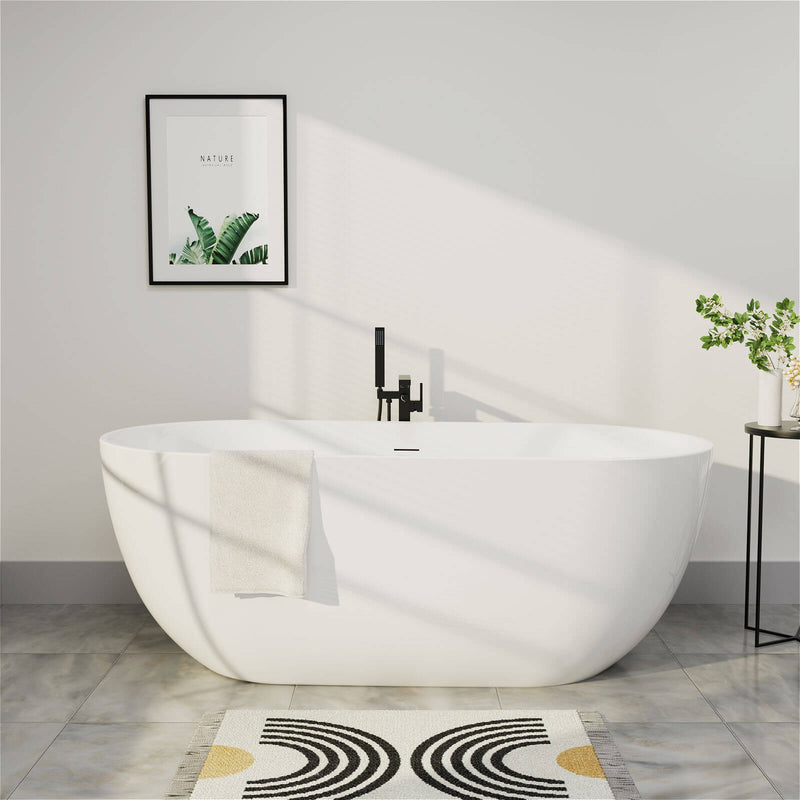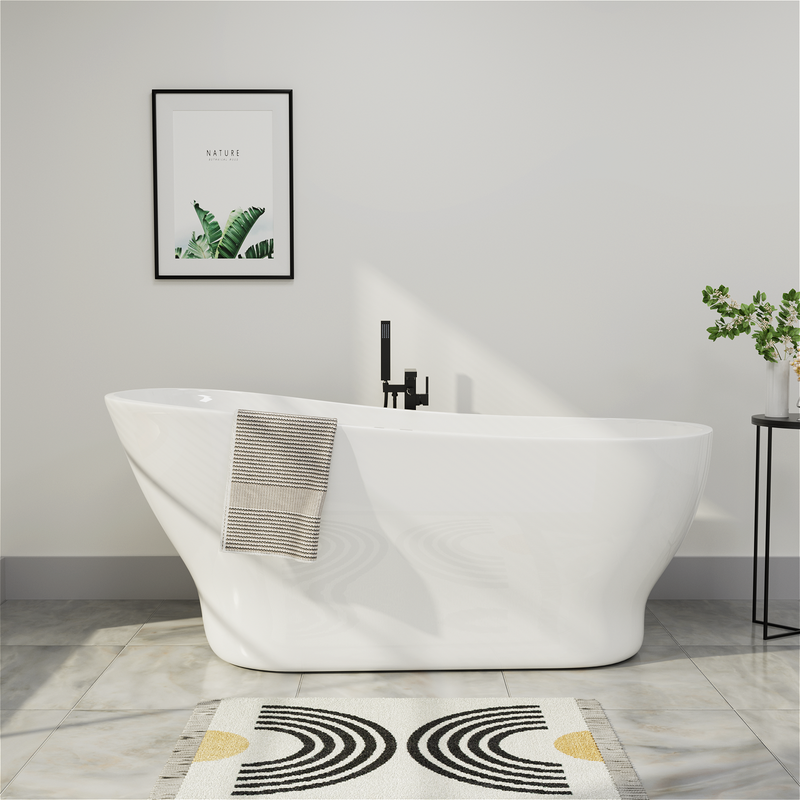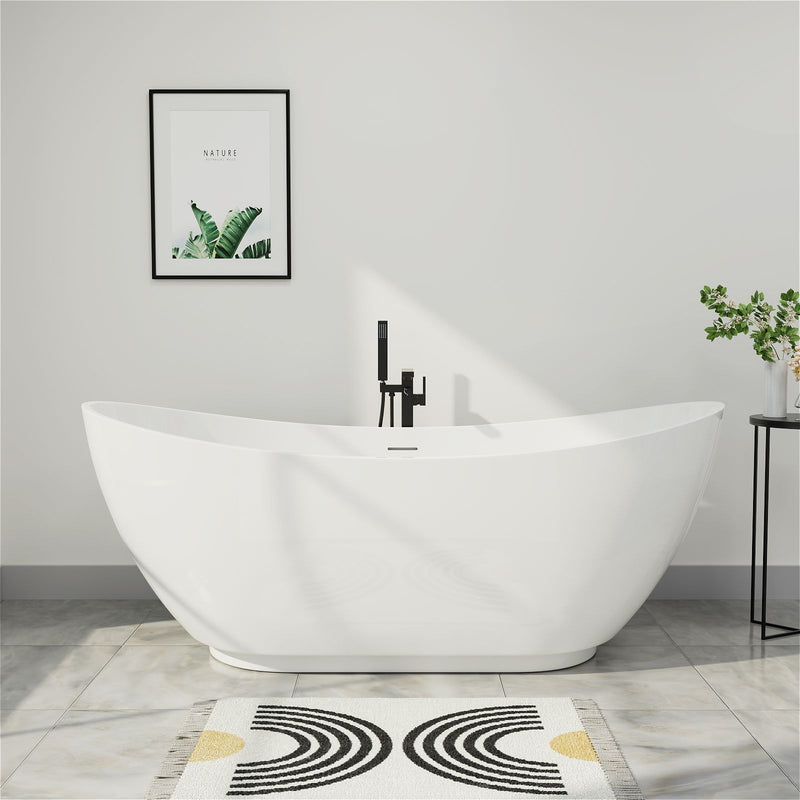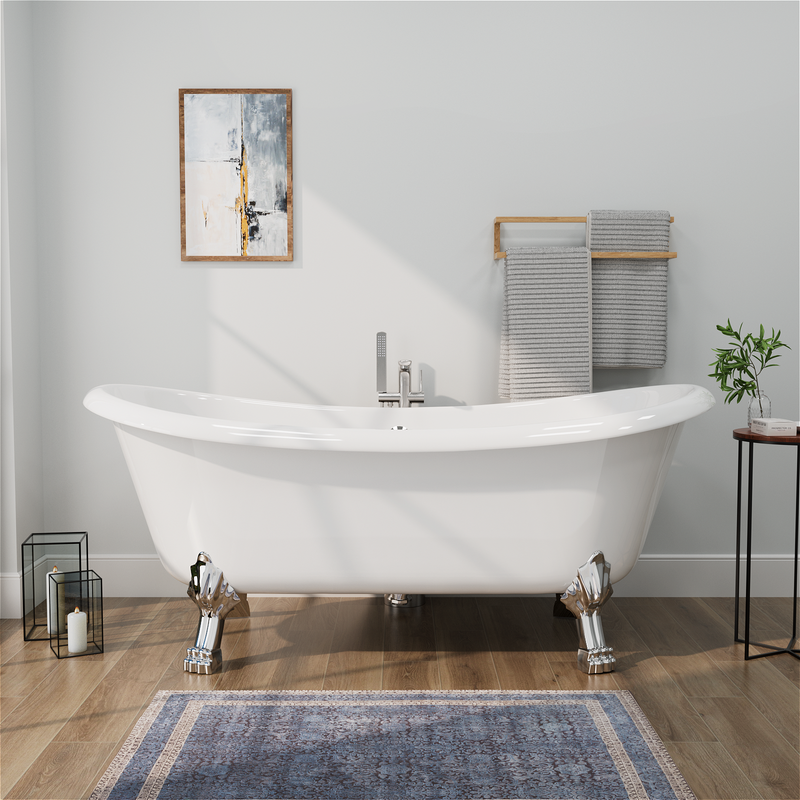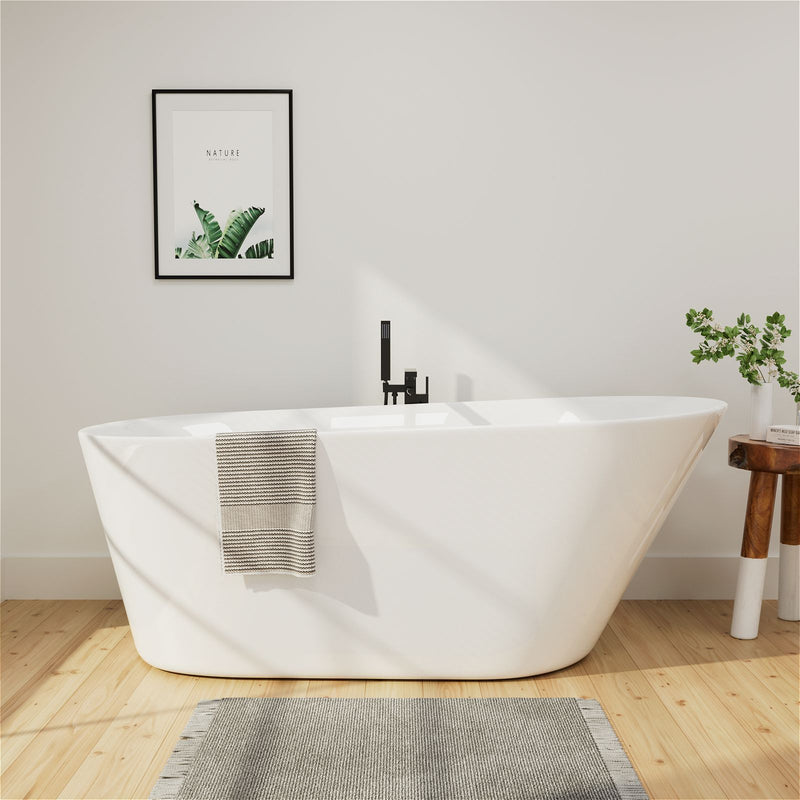The bathtub is more than just a plumbing fixture; it's a sanctuary. It's where we wash away the stress of the day, soothe aching muscles, and find a few moments of quiet solitude. For many, it represents a significant investment in their home's comfort and value. When the time comes to choose a new bathtub, whether for a bathroom remodel or a new construction project, the array of options can be overwhelming. The single most important decision you will make is not about color or shape, but about material.
The material of your bathtub dictates almost everything about it: how it feels to the touch, how long it will last, how much maintenance it requires, how much it costs, and even how long your bathwater stays warm. There is no single "best" material; the ideal choice is a deeply personal one that balances your budget, your aesthetic preferences, and your practical needs for durability and upkeep. This guide will walk you through the most common bathtub materials available on the market today, detailing their characteristics, advantages, and drawbacks in plain language to help you make an informed decision for your home.
Understanding Key Factors in Bathtub Materials
Before diving into the specific materials, it's helpful to understand the core qualities you should be evaluating. When we compare materials like acrylic, cast iron, or stone, we are generally weighing them against the following criteria:
- Durability and Longevity: How resistant is the material to chips, cracks, scratches, and stains? How many years of service can you expect?
- Heat Retention: This is critical for bathers who enjoy long, hot soaks. Some materials, like metal, conduct heat away quickly, while others, like acrylic, insulate it effectively.
- Feel and Comfort: Is the surface of the tub warm and soft to the touch, or is it hard and cold? Is the bottom slippery or textured for safety?
- Maintenance and Cleaning: How easy is it to keep the surface looking clean and new? Is it resistant to mold and mildew, or does it require specific, non-abrasive cleaners?
- Cost and Installation: This includes both the initial purchase price and the cost of professional installation. Some materials are incredibly heavy and may require additional floor reinforcement.
- Design Flexibility: Can the material be easily molded into various shapes, sizes, and colors? This affects the stylistic options available to you.
With these factors in mind, let's explore the most popular bathtub materials.
Acrylic: The All-Around Popular Choice
Acrylic is arguably the most common material for modern bathtubs, particularly for whirlpool and soaking tubs. It is made from sheets of acrylic that are heated and vacuum-formed over a mold into the desired shape. This shell is then reinforced with fiberglass on the underside for added structural support.

Advantages of Acrylic Tubs
The popularity of acrylic is driven by its numerous practical benefits. First and foremost, it is warm to the touch right from the moment you step in, unlike colder materials such as metal or stone. It also possesses excellent heat retention properties, meaning your bathwater will stay hotter for a longer period, enhancing the relaxation experience. From a design perspective, acrylic is highly flexible. It can be molded into a vast array of shapes, sizes, and contours, making it ideal for custom-built alcoves, corner units, and freestanding designs. The material can also be pigmented during the manufacturing process, offering a wide spectrum of color options beyond standard white.
In terms of cost, acrylic tubs are generally very affordable. They strike a good balance between price and performance, offering many of the benefits of premium materials without the exorbitant cost. Furthermore, they are relatively lightweight compared to cast iron or stone, making them easier to handle and install, which can sometimes reduce installation labor costs.
Disadvantages of Acrylic Tubs
The primary trade-off for acrylic's advantages is its durability. The surface is softer and more susceptible to scratching and scuffing than harder materials. Abrasive cleaners or rough scrubbing pads can easily dull and damage the glossy finish over time. While durable under normal use, a heavy, dropped object can potentially cause cracking or damage. Additionally, lower-quality acrylic tubs can be prone to warping or flexing if not properly supported underneath, leading to a feeling of instability. The surface, while non-porous, can be stained by harsh chemicals if not cleaned promptly.
Maintenance and Care. Maintaining an acrylic tub is straightforward but requires a gentle touch. It is essential to use only non-abrasive, soft gel cleaners and a soft cloth or sponge to preserve the glossy surface. Harsh scrubbing or chemicals like bleach can cause irreversible damage. For daily upkeep, a simple wipe-down is usually sufficient.
Fiberglass: The Budget-Friendly Option
Often grouped with acrylic, fiberglass is a related but distinct material. It involves spraying layers of fiberglass strands and resin into a mold, then coating it with a gelcoat finish. It is a common material for lower-cost combination bathtub and shower units.

Advantages of Fiberglass Tubs
The most significant advantage of fiberglass is its incredibly low cost. It is the most inexpensive bathtub material on the market, making it an attractive option for rental properties, budget-conscious renovations, or quick replacements. Like acrylic, it is very lightweight, simplifying the installation process. It is also easy to repair; small cracks and holes can often be patched with a DIY repair kit.
Disadvantages of Fiberglass Tubs
The low cost comes with considerable compromises. Fiberglass tubs are the least durable option. The surface is thin and can feel flimsy, often flexing under weight. They are highly prone to scratching, cracking, and fading over time, especially when exposed to direct sunlight. The gelcoat finish is porous and can become discolored and stained, and it is notoriously difficult to clean to a like-new shine. They also have poorer heat retention than acrylic, meaning water will cool down faster. For a homeowner looking for a long-term, high-quality solution, fiberglass is generally not the recommended choice.
Cast Iron: The Classic Endurance Champion
For over a century, cast iron has been the gold standard for durability and classic appeal. These tubs are made by pouring molten iron into a mold to form the tub, which is then smoothed and finished with a thick, glossy layer of enamel, typically porcelain.

Advantages of Cast Iron Tubs
The word "durability" was invented for cast iron tubs. They are virtually indestructible under normal use. The enameled finish is extremely hard, highly resistant to chips, scratches, stains, and chemicals. You would have to go out of your way with a hammer to cause any significant damage. This resilience means a cast iron tub can last for decades, even a lifetime, often becoming a cherished heirloom passed down through generations. The material also has a significant weight and feels absolutely solid and permanent underfoot, with no flex or give. Aesthetically, they have a timeless, substantial look that conveys quality and tradition. Furthermore, the dense iron has excellent heat retention properties, keeping your water warm throughout a long bath.
Disadvantages of Cast Iron Tubs
The legendary durability of cast iron comes with one very literal heavyweight drawback: its immense weight. A standard cast iron tub can weigh between 300 and 500 pounds on its own. This often necessitates additional structural support in the floor joists and always requires a professional installation with a team of strong movers. The cost is another significant factor; cast iron tubs are among the most expensive options on the market, both for the unit itself and for the specialized installation. The enamel finish, while tough, is not impervious. If a heavy object is dropped on it with enough force, the enamel can chip. While these chips can be professionally repaired, it is a specialized process. The surface can also feel cold to the touch initially until it is warmed by the water.
Enameled Steel: The Practical Compromise
Enameled steel tubs are constructed from sheets of steel that are pressed into shape and then coated with a porcelain enamel finish, similar to cast iron. They offer a middle ground between several materials.

Advantages of Enameled Steel Tubs
These tubs share the same hard, glossy, and easy-to-clean surface as cast iron. They are highly resistant to stains and chemicals and are much easier to keep clean than acrylic or fiberglass. They are also significantly less expensive than cast iron, making a porcelain-like surface more accessible. While still substantial, they are much lighter than cast iron tubs, simplifying handling and installation somewhat.
Disadvantages of Enameled Steel Tubs
The main drawback of steel is that it is a much thinner material than cast iron. This makes it more susceptible to denting from impacts. While the surface is hard, it can be chipped by a sharp, heavy blow. Its biggest functional disadvantage is its poor heat retention. Steel is an excellent conductor of heat, so it draws warmth from the bathwater much faster than acrylic or cast iron. This means your water will cool down more quickly during your soak. The tub itself also feels very cold at first touch. The surface can be noisy during filling and draining, and it can sound "tinny" if knocked.
Stone and Solid Surface: The Ultimate in Luxury and Customization
For those seeking a truly unique and high-end bathing experience, tubs carved from natural stone or molded from engineered solid surface materials represent the pinnacle of luxury.

Advantages of Stone and Solid Surface Tubs
The aesthetic appeal is unmatched. A bathtub carved from a single block of marble, granite, or limestone is a stunning work of natural art, with unique veining and colorations. Engineered solid surface materials, often acrylic-based composites, offer a non-porous, seamless appearance and can be molded into virtually any shape, size, or color, allowing for complete customization. These materials have an incredibly luxurious feel and are exceptionally durable and resistant to scratches (in the case of solid surface) and stains. They exhibit excellent heat retention, similar to or better than cast iron. A stone or solid surface tub becomes the undeniable focal point of a bathroom and can significantly increase a home's value.
Disadvantages of Stone and Solid Surface Tubs
The most obvious disadvantage is the extreme cost. Natural stone tubs are the most expensive option available, often costing many thousands of dollars for the material alone. They are also phenomenally heavy, far exceeding even cast iron. Installation is a major undertaking that requires significant structural reinforcement and a team of experts. Natural stone is a porous material and requires periodic sealing to prevent staining and bacterial growth. Even engineered solid surface materials can be susceptible to damage from very high heat. This is an option only for those with a generous budget and a commitment to creating a truly custom luxury space.
Cultured Marble: The Economical Look-Alike
Cultured marble is a man-made material created by blending crushed marble dust with polyester resins. This mixture is then poured into a mold and coated with a clear, protective gel coat. It is designed to mimic the appearance of real marble at a fraction of the cost.

Advantages of Cultured Marble Tubs
The primary advantage of marble tubs is its aesthetic. It offers the elegant look of veined marble in a wide range of colors and patterns for a much more affordable price. It is a non-porous material when the gel coat is intact, making it resistant to stains and relatively easy to clean. It is also heavier and feels more substantial than fiberglass, though not as much as cast iron.
Disadvantages of Cultured Marble Tubs
The gel coat surface is susceptible to scratching and can chip if struck with a hard object. Over time, especially with the use of abrasive cleaners, the glossy finish can become dull and lose its luster. Unlike a solid surface acrylic tub, it is very difficult to restore this shine once it is gone, as buffing can remove the protective gel coat entirely. It is generally considered a mid-range option in terms of both price and durability.
Conclusion: Finding Your Perfect Fit
Choosing the right bathtub material is a process of aligning your desires with practical reality. There is no universal winner, only the best choice for your specific situation.
For the budget-minded homeowner or landlord, fiberglass offers a basic, no-frills solution. If you desire a modern look, a variety of shapes, warm water retention, and a good balance of cost and performance, acrylic is the overwhelming and popular choice. For those who value timeless tradition, unparalleled durability, and are prepared for the investment in cost and installation, the cast iron tub remains a magnificent, lifelong investment. Enameled steel provides a cost-effective way to get a classic, easy-to-clean surface if you can accept faster heat loss.
Finally, for the ultimate statement of luxury and custom design, where budget is a secondary concern, natural stone and engineered solid surface materials create a spa-like sanctuary that is uniquely yours.
Remember to consider how you use your bath. Are you a quick-shower person or a dedicated soaker? Do you have young children who might be rough on surfaces? What is the structural capacity of your bathroom floor? By carefully weighing the properties of each material against your lifestyle, budget, and design dreams, you can select a bathtub that you will enjoy and cherish for years to come. Your perfect bath awaits.

